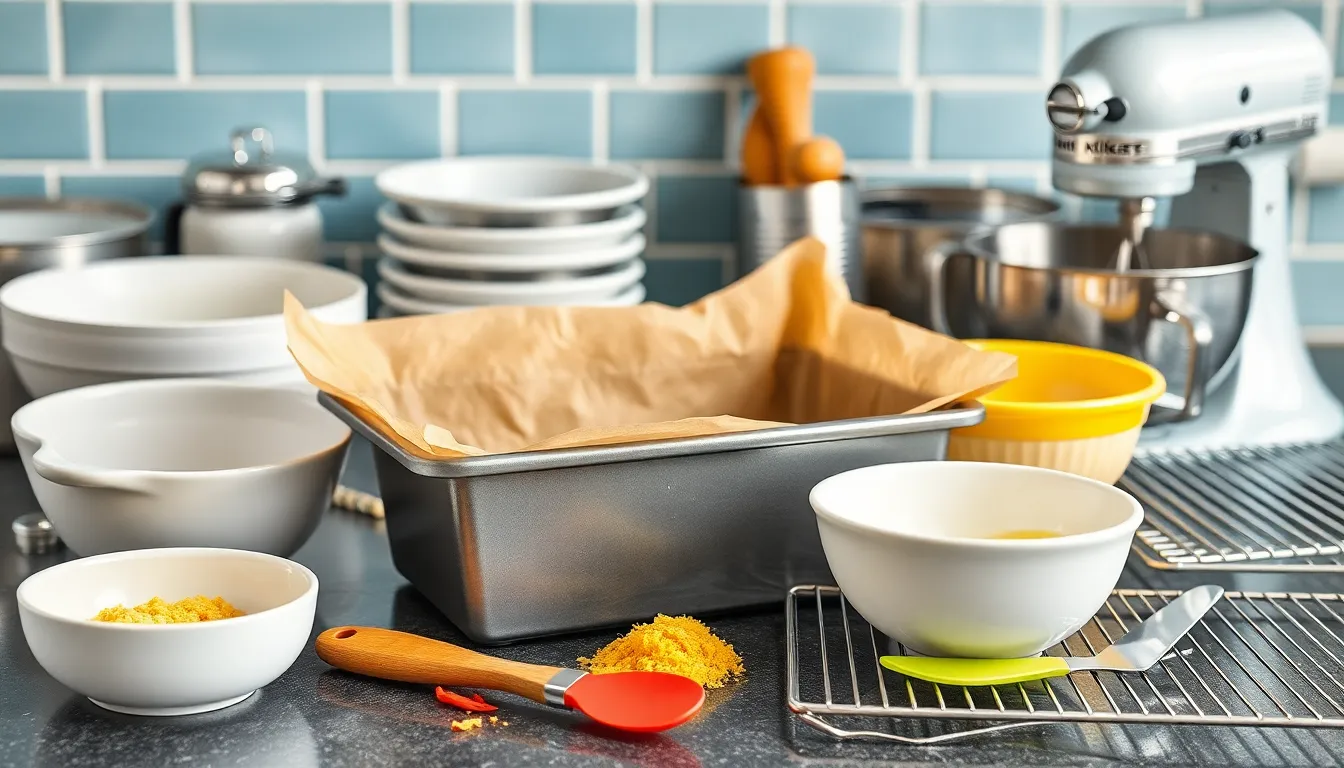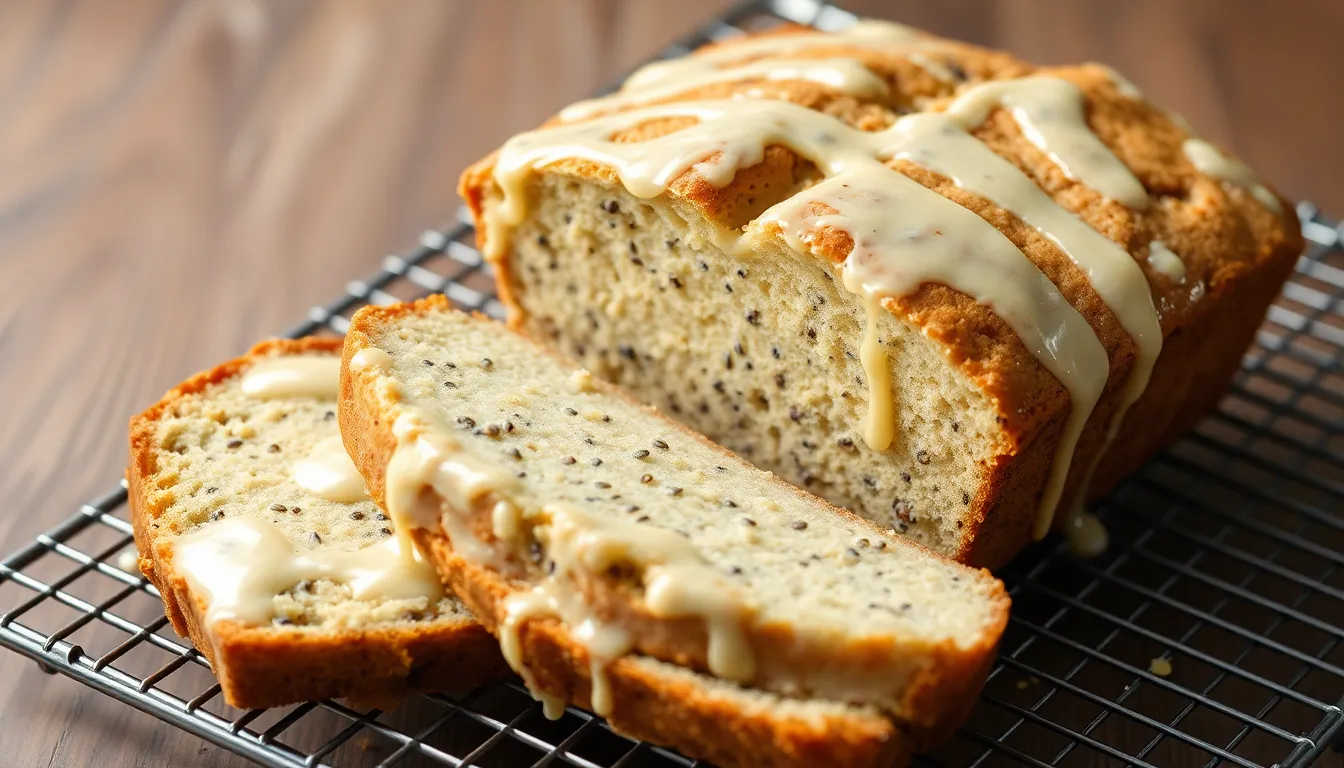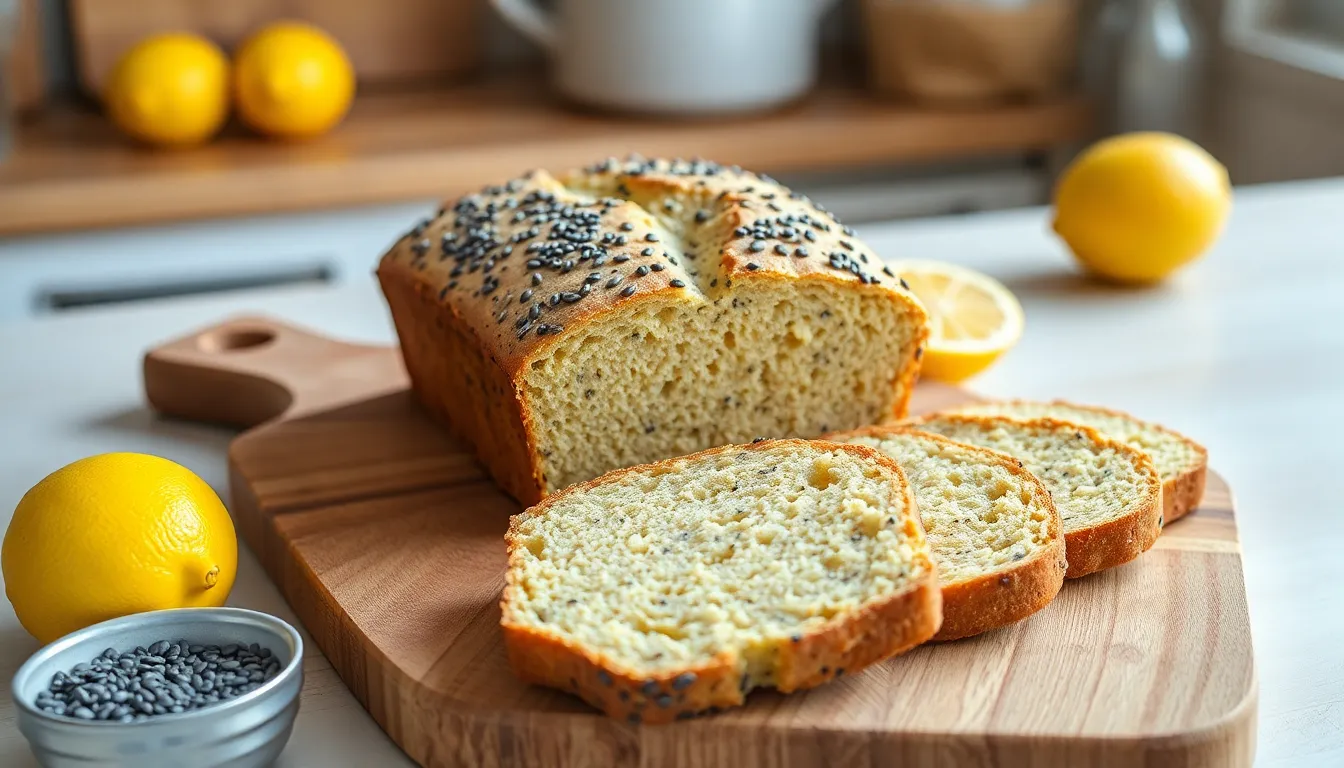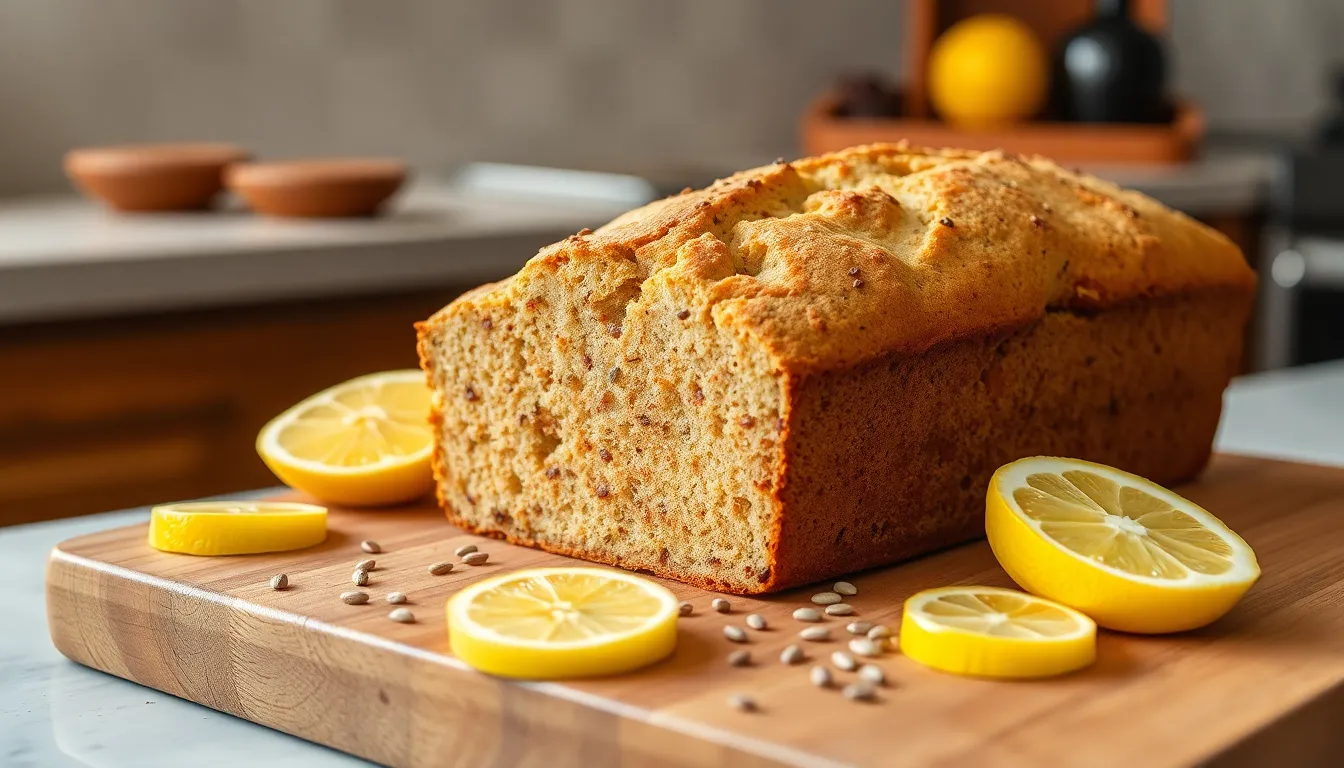We can’t resist the perfect combination of bright citrus and delicate crunch that makes lemon poppy seed loaf such a beloved classic. This tender, moist cake strikes the ideal balance between sweet and tart while those tiny poppy seeds add just the right amount of texture and visual appeal.
There’s something magical about how the zesty lemon flavor transforms a simple loaf into something extraordinary. Whether you’re enjoying a slice with your morning coffee or serving it as an elegant dessert, this timeless recipe never fails to impress. The fragrant aroma alone will have your kitchen smelling absolutely divine.
We’ve perfected this recipe to ensure you get that coveted tender crumb and vibrant lemon taste every single time. With just a few simple ingredients and straightforward techniques, you’ll create a bakery-quality loaf that’s bound to become your new go-to treat.
Ingredients
Our lemon poppy seed loaf recipe requires two sets of ingredients: one for the moist cake base and another for the bright finishing glaze. We’ve organized everything in the order you’ll use them to streamline your baking process.
For the Lemon Poppy Seed Loaf
- 1¾ cups all-purpose flour
- 1 cup granulated sugar
- 2 tablespoons poppy seeds
- 1½ teaspoons baking powder
- ½ teaspoon salt
- ⅓ cup unsalted butter, melted and cooled slightly
- 1 large egg, room temperature
- 1 cup whole milk
- ¼ cup fresh lemon juice (about 2 large lemons)
- 2 tablespoons lemon zest (about 2 large lemons)
- 1 teaspoon vanilla extract
For the Lemon Glaze
- 1 cup powdered sugar, sifted
- 3-4 tablespoons fresh lemon juice
- 1 tablespoon lemon zest
- Pinch of salt
Equipment Needed

Creating the perfect lemon poppy seed loaf requires the right tools to ensure our baking success. We recommend gathering all equipment before starting to streamline the baking process.
Our primary vessel is a 9×5 inch loaf pan or 8×4 inch loaf pans for consistent baking results. These standard sizes provide the ideal shape and depth for even heat distribution throughout our loaf.
Parchment paper serves as our non-stick insurance policy when lining the loaf pan. This simple step prevents sticking and makes removal effortless once our loaf finishes baking.
We need several mixing bowls for combining our ingredients properly. Separate bowls allow us to mix wet and dry ingredients individually before bringing them together for the perfect batter consistency.
A rubber spatula becomes essential for scraping the sides of bowls thoroughly. This tool ensures we incorporate every bit of our carefully measured ingredients without waste.
Fresh lemon zest elevates our loaf’s citrus flavor, making a zester crucial for extracting those aromatic oils from the lemon peel. The fine zest distributes evenly throughout our batter.
An electric mixer or whisk handles the heavy lifting when combining our butter, sugar, and eggs. This equipment creates the light, fluffy texture that makes our loaf irresistibly tender.
Finally, a cooling rack provides proper air circulation around our finished loaf. This prevents soggy bottoms and allows our glaze to set beautifully when we’re ready to add that final citrusy touch.
Instructions

Follow these step-by-step instructions to create our perfectly moist and flavorful lemon poppy seed loaf. We’ll walk you through each stage to ensure bakery-quality results every time.
Prep
We begin by preheating our oven to 350°F (177°C) for optimal baking temperature. Line our 9×5 inch loaf pan with parchment paper and lightly grease the sides to prevent sticking. This preparation step ensures easy removal and perfectly shaped edges on our finished loaf.
Make the Batter
We start by whisking together 1 ¾ cups all-purpose flour, 1 teaspoon baking powder, ½ teaspoon salt, and 2 tablespoons poppy seeds in our large mixing bowl. In a separate bowl, we cream ¾ cup softened butter with ¾ cup sugar using our electric mixer until light and fluffy, about 3-4 minutes. Beat in 3 large eggs one at a time, ensuring each egg is fully incorporated before adding the next. We then mix in 2 tablespoons fresh lemon juice and the zest of 2 lemons for that bright citrus flavor. Alternating between our dry ingredients and ¾ cup milk, we gently fold everything together until just combined, being careful not to overmix.
Bake the Loaf
Pour our prepared batter into the lined loaf pan, spreading it evenly with our rubber spatula. We bake for 50-60 minutes, checking for doneness by inserting a toothpick into the center. The loaf is ready when the toothpick comes out with just a few moist crumbs attached. Cover the top with aluminum foil halfway through baking if it browns too quickly, protecting the surface while ensuring even cooking throughout.
Prepare the Glaze
While our loaf bakes, we prepare the finishing glaze by whisking together powdered sugar and fresh lemon juice until smooth. Start with 1 cup powdered sugar and add lemon juice gradually until we achieve our desired consistency. The glaze should be thick enough to coat the back of a spoon but thin enough to drizzle smoothly over the warm loaf.
Finish and Cool
We allow the baked loaf to cool in the pan for 10 minutes before carefully transferring it to our wire cooling rack. Drizzle the prepared glaze over the warm loaf, allowing it to soak into the surface for extra moisture and flavor. Let our lemon poppy seed loaf cool completely before slicing, which takes approximately 30-45 minutes and ensures clean, even cuts.
Storage Instructions

Proper storage keeps our lemon poppy seed loaf fresh and delicious for days after baking. We recommend following these guidelines to maintain the loaf’s moist texture and bright citrus flavor.
Room Temperature Storage
Store our freshly baked lemon poppy seed loaf at room temperature in an airtight container. The loaf stays fresh for 3 to 5 days when properly sealed and kept away from direct sunlight and high humidity. We find that airtight storage prevents the loaf from drying out while preserving its tender crumb.
Refrigerator Storage
For extended freshness, we suggest refrigerating the loaf in an airtight container. Refrigerated storage extends the loaf’s life to 4 to 5 days. Always allow refrigerated loaf to return to room temperature before serving to restore its optimal texture and flavor.
Freezing Instructions
Freezing our lemon poppy seed loaf preserves it for up to 3 months. We recommend allowing the loaf to cool completely before wrapping it tightly in plastic wrap followed by aluminum foil to prevent freezer burn.
For convenient individual servings, cut the loaf into slices and wrap each piece separately in plastic wrap. Store wrapped slices in a freezer safe container for the same 3 month period. This method prevents the slices from drying out and allows us to thaw only what we need.
| Storage Method | Container Type | Duration | Temperature |
|---|---|---|---|
| Room Temperature | Airtight container | 3-5 days | Room temperature |
| Refrigerated | Airtight container | 4-5 days | Refrigerated |
| Frozen (whole loaf) | Plastic wrap + foil | 3 months | Frozen |
| Frozen (slices) | Individual wrap + container | 3 months | Frozen |
Thawing and Serving
Thaw frozen loaves in the refrigerator overnight or at room temperature for quicker results. We always bring thawed loaf to room temperature before serving to ensure the best taste and texture. Apply fresh icing after thawing if we froze the loaf without its glaze to maintain the bright lemon flavor and attractive appearance.
Serving Suggestions

Our perfectly baked lemon poppy seed loaf shines when served at the right temperature and paired with complementary beverages. We recommend serving this delightful treat at room temperature to appreciate its tender crumb and vibrant lemon flavor fully. During warmer months, chilled slices provide a refreshing dessert experience that highlights the citrus notes beautifully.
Beverage pairings elevate the enjoyment of our lemon poppy seed loaf significantly. Hot tea creates a classic combination that brings out the subtle poppy seed texture while balancing the bright acidity. Boba tea offers a modern twist that appeals to those seeking unique flavor combinations. Cold beverages like Pink Drinks or Mocha Frappuccinos provide delightful contrasts that make our loaf suitable for casual gatherings and coffee shop experiences.
Toppings transform our simple loaf into an indulgent dessert worthy of special occasions. A dollop of freshly whipped cream adds richness that complements the lemony brightness without overwhelming the delicate flavors. Vanilla ice cream creates a temperature contrast that enhances both the warm and cool elements of this dessert experience.
Special presentation ideas make our lemon poppy seed loaf perfect for afternoon tea or elegant events. Candied lemon slices arranged artfully on top create visual appeal while intensifying the citrus theme. Our lemon glaze drizzled generously over the loaf adds both sweetness and professional bakery appearance that impresses guests.
The versatility of our lemon poppy seed loaf makes it suitable for various serving occasions throughout the day. Morning coffee pairs naturally with thick slices that provide satisfying breakfast sustenance. Afternoon snacks benefit from thinner portions that satisfy without overwhelming. Evening dessert presentations allow for creative plating that showcases the beautiful speckled interior and glossy glaze finish.
Recipe Variations

We love experimenting with different twists on our classic lemon poppy seed loaf to create unique flavors and presentations. These variations maintain the beloved essence of the original while offering exciting new taste experiences.
Meyer Lemon Version
Meyer lemons transform our traditional loaf into something truly special with their sweeter and less acidic profile. We replace the regular lemon juice and zest with equal amounts of Meyer lemon equivalents throughout the recipe. The result delivers a more delicate citrus flavor that feels both bright and mellow.
This variation works particularly well when we want a sophisticated dessert that isn’t overpowering. Meyer lemons create a naturally sweeter loaf that requires no adjustment to our sugar measurements. We find this version pairs beautifully with Earl Grey tea or champagne for elegant occasions.
Almond Poppy Seed Loaf
Our almond variation adds depth and richness by incorporating almond extract and substituting sour cream or Greek yogurt for some of the milk. We add 1 teaspoon of pure almond extract to the wet ingredients and replace half the milk with an equal amount of sour cream or Greek yogurt.
The sour cream provides extra moisture while contributing a subtle tang that balances the sweet almond flavor. This combination creates a denser texture with nutty undertones that complement the poppy seeds perfectly. We recommend using this variation when serving the loaf as an afternoon treat with coffee.
Mini Loaf Option
Dividing our standard batter into smaller loaf pans creates adorable individual servings perfect for gifting or entertaining. We use 4 to 6 mini loaf pans (approximately 3×5 inches each) and reduce the baking time to 25-30 minutes.
| Pan Size | Baking Time | Servings |
|---|---|---|
| Standard 9×5 inch | 45-50 minutes | 8-10 slices |
| Mini 3×5 inch | 25-30 minutes | 4-6 individual loaves |
These bite-sized versions bake faster and make portion control easier. We love preparing mini loaves for parties since guests can enjoy a complete individual serving without needing to slice a larger loaf. The smaller size also allows us to experiment with different glazes on each loaf for variety.
Troubleshooting Tips

Even the most experienced bakers encounter challenges when making lemon poppy seed loaf. We’ve identified the most common issues and their answers to help you achieve bakery-perfect results every time.
When Your Loaf Sinks Around the Edges
Uneven sinking occurs when the top surface sets before the leavening agents finish their work. This creates an unfortunate domed effect that can make your beautiful loaf look unprofessional. We recommend ensuring your oven heats evenly and avoiding overmixing the batter, which can break down the delicate structure needed for proper rising.
Solving Dry Texture Problems
Poppy seeds naturally absorb moisture from your batter, which can lead to an unexpectedly dry final product. We suggest measuring poppy seeds carefully using 2 to 3 tablespoons maximum and distributing them evenly throughout the batter. This prevents concentrated areas where moisture gets absorbed too heavily.
Managing Large Cracks on Top
While some cracking indicates proper bread expansion, excessive cracks suggest over-leavening in your recipe. We find that measuring baking powder precisely and checking expiration dates prevents this common issue. Fresh leavening agents provide controlled lift without creating dramatic fissures.
Preventing Pan Sticking Issues
Nothing ruins a perfect loaf like having it stick to the pan and tear apart during removal. We always grease our loaf pan thoroughly with butter and dust it with flour, paying special attention to the corners and edges where sticking most commonly occurs.
Boosting Weak Lemon Flavor
Insufficient citrus brightness disappoints anyone expecting that signature lemon punch. We use only freshly squeezed lemon juice and incorporate lemon zest directly into our batter for maximum flavor impact. Bottled juice simply cannot match the vibrant taste of fresh lemons.
Essential Success Strategies
Room temperature ingredients blend more smoothly and create better texture in your finished loaf. We bring eggs, milk, and butter to room temperature about an hour before baking begins.
Oven temperature accuracy makes the difference between success and disappointment. We preheat our oven completely and use an oven thermometer to verify the actual temperature matches our settings.
Complete cooling prevents your loaf from breaking apart when sliced. We resist the temptation to cut into warm bread and allow at least one hour of cooling time before serving.
Conclusion
We’ve shared everything you need to create a bakery-quality lemon poppy seed loaf that’ll become your go-to recipe. From the essential ingredients and equipment to step-by-step instructions and storage tips we’ve covered all the details that make the difference between good and extraordinary.
The beauty of this loaf lies in its simplicity and versatility. Whether you’re serving it for breakfast with morning coffee or dressing it up with candied lemon slices for guests you’ll have a dessert that never disappoints.
With our troubleshooting guide and recipe variations you’re equipped to handle any baking challenges and customize the loaf to your taste preferences. We’re confident that once you try this recipe you’ll understand why lemon poppy seed loaf holds such a special place in our hearts and kitchens.
Frequently Asked Questions
What ingredients do I need for lemon poppy seed loaf?
You’ll need all-purpose flour, granulated sugar, poppy seeds, baking powder, salt, melted butter, an egg, whole milk, fresh lemon juice, lemon zest, and vanilla extract for the cake. For the glaze, gather powdered sugar, fresh lemon juice, lemon zest, and a pinch of salt.
What equipment is essential for making this loaf?
Essential equipment includes a 9×5 inch or 8×4 inch loaf pan, parchment paper, mixing bowls, a rubber spatula, an electric mixer or whisk, and a cooling rack. These tools ensure even baking, proper mixing, and ideal cooling conditions for the best results.
What temperature should I bake the lemon poppy seed loaf?
Bake the lemon poppy seed loaf at 350°F (177°C). This temperature ensures even cooking throughout the loaf while preventing the outside from browning too quickly before the center is fully baked.
How do I know when the loaf is done baking?
Test for doneness by inserting a toothpick into the center of the loaf. If it comes out clean or with just a few moist crumbs, the loaf is ready. The top should also be golden brown and spring back lightly when touched.
How should I store lemon poppy seed loaf?
Store at room temperature in an airtight container for 3-5 days, or refrigerate for 4-5 days. For long-term storage, wrap tightly and freeze for up to 3 months. Always allow refrigerated loaf to come to room temperature before serving.
Can I make variations of this recipe?
Yes! Try Meyer lemon for a sweeter flavor, or substitute almond extract for vanilla and add sour cream for an almond poppy seed version. You can also make mini loaves for individual servings, adjusting baking time accordingly.
What are the best serving suggestions for lemon poppy seed loaf?
Serve at room temperature to enjoy the tender crumb and vibrant flavor. Pair with hot tea, coffee, or cold beverages. Add whipped cream or vanilla ice cream for dessert, or garnish with candied lemon slices for elegant occasions.
Why did my loaf turn out dry or crack?
Dry texture often results from overbaking or incorrect ingredient measurements. Large cracks indicate oven temperature is too high. Use room temperature ingredients, measure accurately, and check oven temperature with a thermometer for best results.







